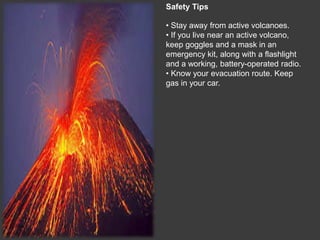volcanoes
- 2. A volcano is an opening, or rupture, in the surface or crust of the Earth or a planetary mass object, which allows hot lava, volcanic ash and gases to escape from the magma chamber below the surface. Erupting volcanoes can pose many hazards, not only in the immediate vicinity of the eruption. Volcanic ash can be a threat to aircraft, in particular those with jet engines where ash particles can be melted by the high operating temperature; the melted particles then adhere to the turbine blades and alter their shape.
- 3. LAVA DOMES Lava domes are built by slow eruptions of highly viscous lavas. They are sometimes formed within the crater of a previous volcanic eruption (as in Mount Saint Helens), but can also form independently, as in the case of Lassen Peak. Like stratovolcanoes, they can produce violent, explosive eruptions, but their lavas generally do not flow far from the originating vent.
- 4. Shield volcanoes, so named for their broad, shield-like profiles, are formed by the eruption of low-viscosity lava that can flow a great distance from a vent. They generally do not explode catastrophically. Since low-viscosity magma is typically low in silica, shield volcanoes are more common in oceanic than continental settings. The Hawaiian volcanic chain is a series of shield cones, and they are common in Iceland, as well. Shield volcanoes
- 5. Volcanic cones or cinder cones result from eruptions of mostly small pieces of scoria and pyroclastics (both resemble cinders, hence the name of this volcano type) that build up around the vent. These can be relatively short-lived eruptions that produce a cone-shaped hill perhaps 30 to 400 meters high. Most cinder cones erupt only once. Cinder cones may form as flank vents on larger volcanoes, or occur on their own. ParÃcutin in Mexico and Sunset Crater in Arizona are examples of cinder cones. In New Mexico, Caja del Rio is a volcanic field of over 60 cinder cones.
- 7. Crypto domes are formed when viscous lava forces its way up and causes a bulge. The 1980 eruption of Mount St. Helens was an example. Lava was under great pressure and forced a bulge in the mountain, which was unstable and slid down the north side. Crypto domes
- 8. Safety Tips âĒ Stay away from active volcanoes. âĒ If you live near an active volcano, keep goggles and a mask in an emergency kit, along with a flashlight and a working, battery-operated radio. âĒ Know your evacuation route. Keep gas in your car.
- 9. If a Volcano Erupts in Your Area âĒ Evacuate only as recommended by authorities to stay clear of lava, mud flows, and flying rocks and debris. âĒ Avoid river areas and low-lying regions. âĒ Before you leave the house, change into long-sleeved shirts and long pants and use goggles or eyeglasses, not contacts. Wear an emergency mask or hold a damp cloth over your face. âĒ If you are not evacuating, close windows and doors and block chimneys and other vents, to prevent ash from coming into the house. âĒ Be aware that ash may put excess weight on your roof and need to be swept away. Wear protection during cleanups. âĒ Ash can damage engines and metal parts, so avoid driving. If you must drive, stay below 35 miles (56 kilometers) an hour.










